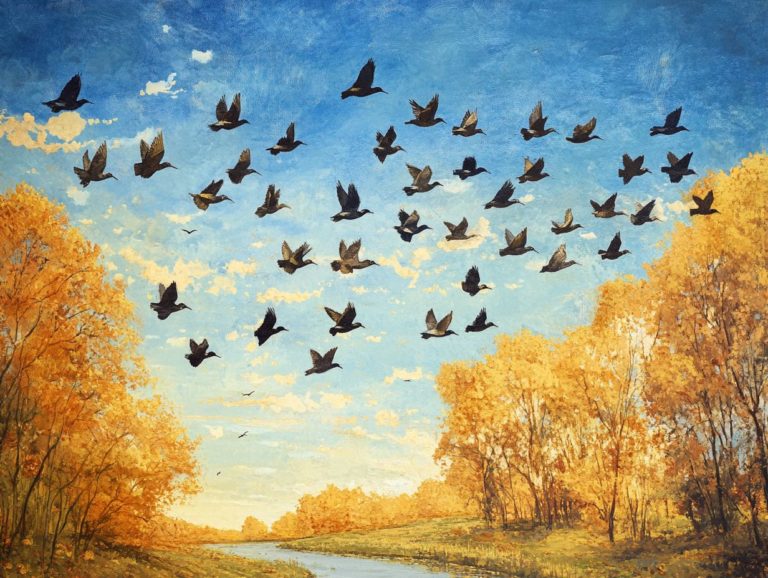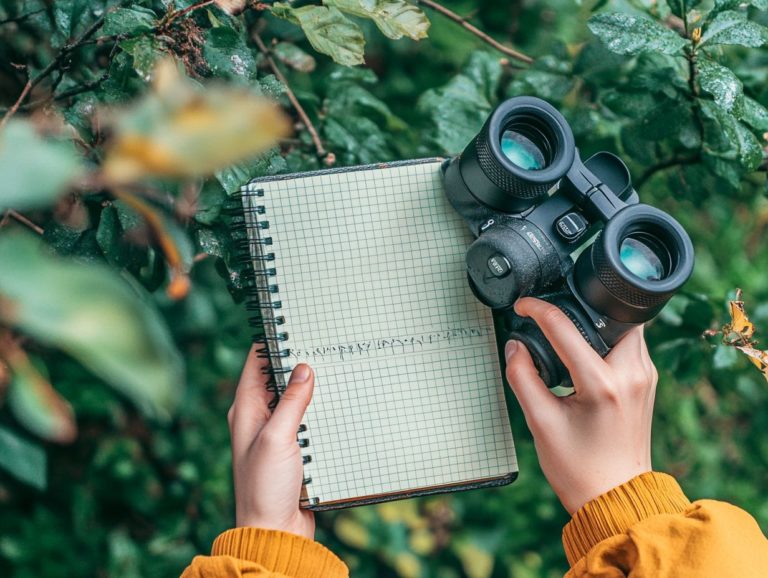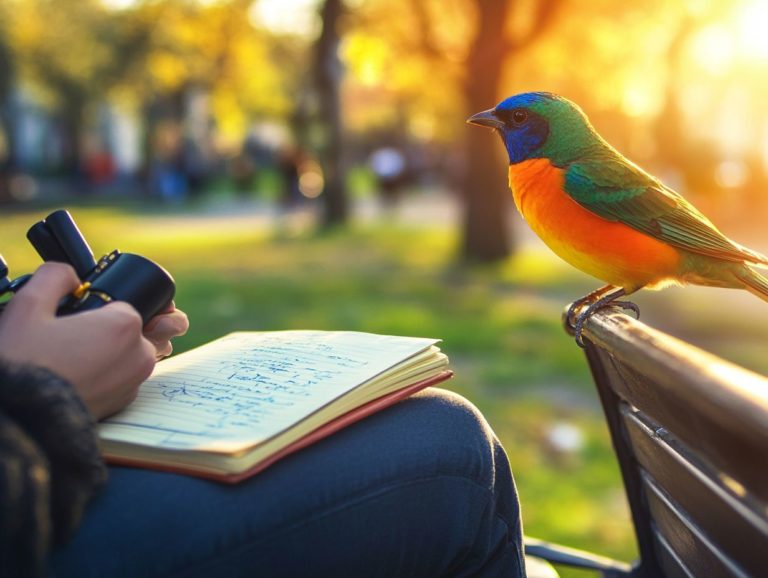What Makes Bird Watching a Unique Experience?
Bird watching offers you a unique blend of adventure, tranquility, and a deep connection with nature.
It invites you to step outside, immerse yourself in diverse ecosystems, and discover the captivating world of avian life. This article delves into the myriad benefits of bird watching for both your physical and mental well-being.
You ll find essential gear and preparation tips, uncover the best locations for spotting birds, and learn valuable skills for identifying various species.
Proper etiquette is crucial for protecting birds and their habitats, ensuring a sustainable and enjoyable bird watching experience. Whether you’re a seasoned birder or just curious about the hobby, there s something valuable here for everyone.
Contents
Key Takeaways:
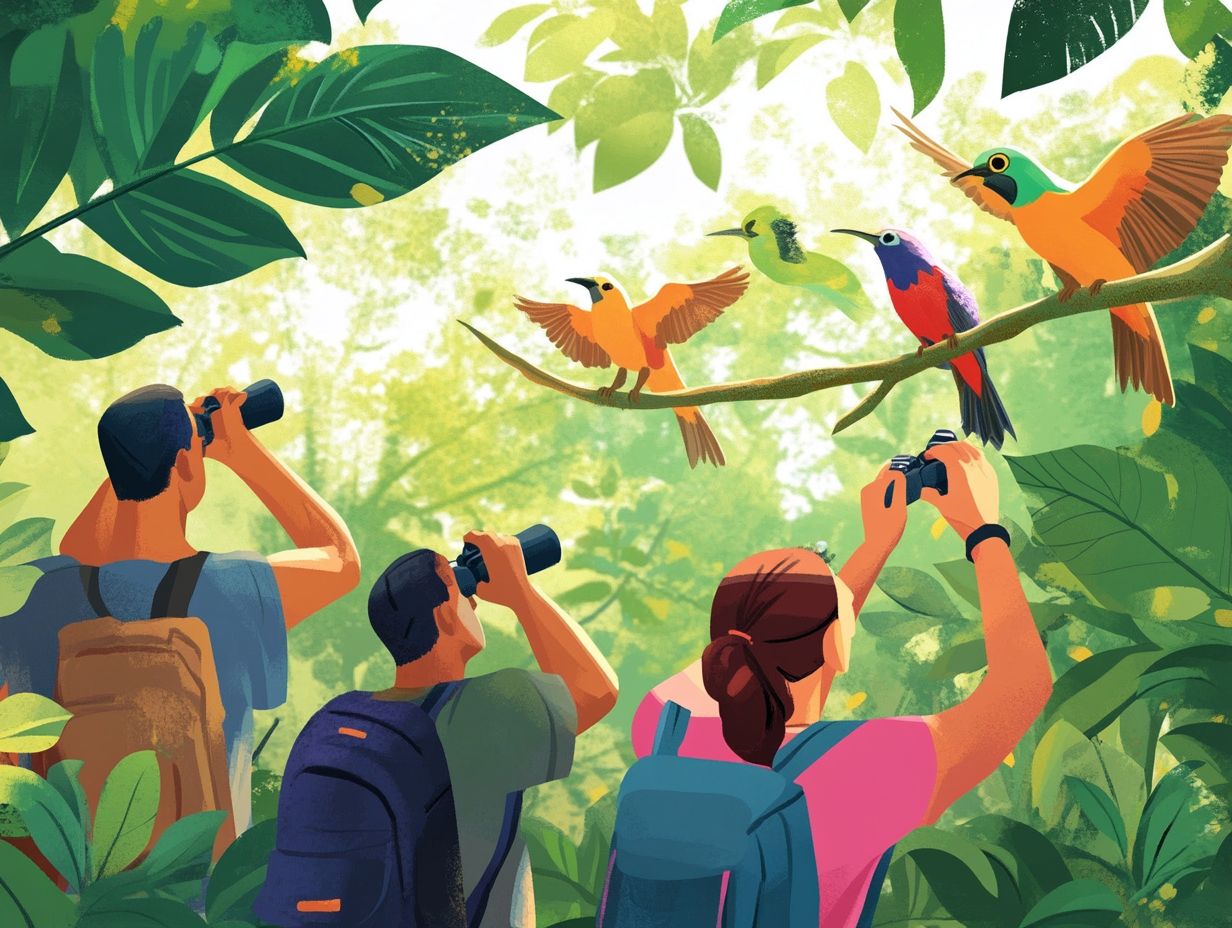
- Bird watching provides both physical and mental health benefits.
- Essential equipment like binoculars makes your trip successful.
- Practicing good etiquette helps protect birds and their habitats.
What is Bird Watching?
Birdwatching, or birding, is a captivating hobby that invites you to explore the stunning diversity of bird species in a range of settings from peaceful natural habitats to vibrant urban landscapes.
This engaging pursuit nurtures a deep appreciation for birds and fosters a stronger connection with nature. With every sighting, you experience a delightful mix of joy and curiosity, paving the way for scientific discovery and a richer understanding of your environment.
At its core, birdwatching elevates your well-being by reducing stress and encouraging mindfulness. It cultivates a sense of community through shared experiences and conversations.
You ll find yourself connecting with fellow enthusiasts in local groups or organized events, where knowledge and strategies are exchanged, creating a wonderful sense of camaraderie.
Birdwatching is not just a hobby; it’s a call to protect our planet and its beautiful creatures. Engaging with the avian world allows you to develop a stronger sense of responsibility toward nature, making birdwatching a gateway to both personal fulfillment and collective action for a sustainable future.
Benefits of Bird Watching
Birdwatching presents a wealth of benefits that elevate mental well-being, strengthen community ties, and encourage environmental stewardship, transforming it into a delightful pursuit for enthusiasts of every age.
By embracing this fulfilling hobby, you can dive into the breathtaking beauty of nature, nurture friendships, and forge meaningful connections with the world around you.
Physical and Mental Health Benefits
The physical and mental health benefits of birdwatching are truly remarkable. Engaging in this delightful hobby offers you a chance to exercise, relax, and enhance your overall well-being as you immerse yourself in the beauty of nature.
As you stroll through parks or forests, the gentle rhythm of your footsteps transforms into invigorating exercise, while allowing your mind to unwind. The vibrant colors and melodious songs of various birds effortlessly capture your attention, drawing you into a state of mindfulness that promotes stress reduction.
This connection to the outdoors fosters relaxation and cultivates a sense of belonging within the ecosystem. Research indicates that immersing yourself in nature especially through hobbies like birdwatching can lead to lower blood pressure, improved mood, and enhanced emotional health.
It s a fulfilling activity that nourishes both your body and spirit.
What You Need for Bird Watching

Start your exciting journey in bird watching with the right gear! You must equip yourself with must-have tools and prepare properly to elevate your observation experience and fully enjoy this fun hobby.
The right binoculars the special glasses that help you see birds from far away field guides, and accessories are crucial in allowing you to engage deeply with the avian world, enriching your connection with these fascinating creatures.
Essential Equipment and Preparation
Essential equipment for your bird watching journey includes high-quality binoculars, bird feeders, and photography gear, all of which enhance your experience. Proper preparation helps you make the most of your time in the field and enhances your overall enjoyment of this fun hobby.
To ensure a truly immersive experience in avian observation, investing in top-notch binoculars is crucial. They provide the clarity and focus that reveal the intricate details of feather patterns and behaviors.
Incorporating bird feeders into your backyard can attract a vibrant array of species, creating a live-action viewing spectacle right at home.
Your photography gear, especially a camera with a zoom lens, becomes invaluable for capturing those fleeting moments, allowing you to document your encounters with precision. Other essential tools, like field guides, help you identify various species, while a well-planned gear checklist ensures you’re prepared for any weather conditions, further enhancing your bird watching adventure.
Where to Go Bird Watching
Choosing the right spots and seasons for bird watching can make your experience unforgettable! Whether you re wandering through urban parks such as Central Park or uncovering hidden gems in regions like North Jersey, you ll find a rich tapestry of avian life to explore year-round, turning each trip into an exciting new adventure!
Best Locations and Seasons
The best locations for bird watching truly depend on the season and the specific habitats that different bird species prefer, creating a rich tapestry of opportunities just waiting for you to explore. Picture yourself in the lush forests of Dane County during spring, or wandering through the vibrant urban parks of Bengaluru; each environment offers its own unique bird watching adventure.
During the summer months, the coastal wetlands of Florida beckon with a diverse array of wading birds. Here, you might spot roseate spoonbills and great blue herons gracefully navigating the serene landscape.
As autumn rolls in, the majestic migration the movement of birds from one place to another, usually with the changing seasons along the Atlantic Flyway unfolds in stunning locations like Cape May, New Jersey. Witnessing the breathtaking convergence of species here is nothing short of magical.
For those who revel in winter, the tranquil salt marshes of San Francisco Bay provide a soothing backdrop for observing various shorebirds huddled against the crisp air.
Each of these locations encapsulates the unique charm of both urban and natural habitats, enriching your bird watching experience throughout the seasons.
Identifying Birds in the Wild
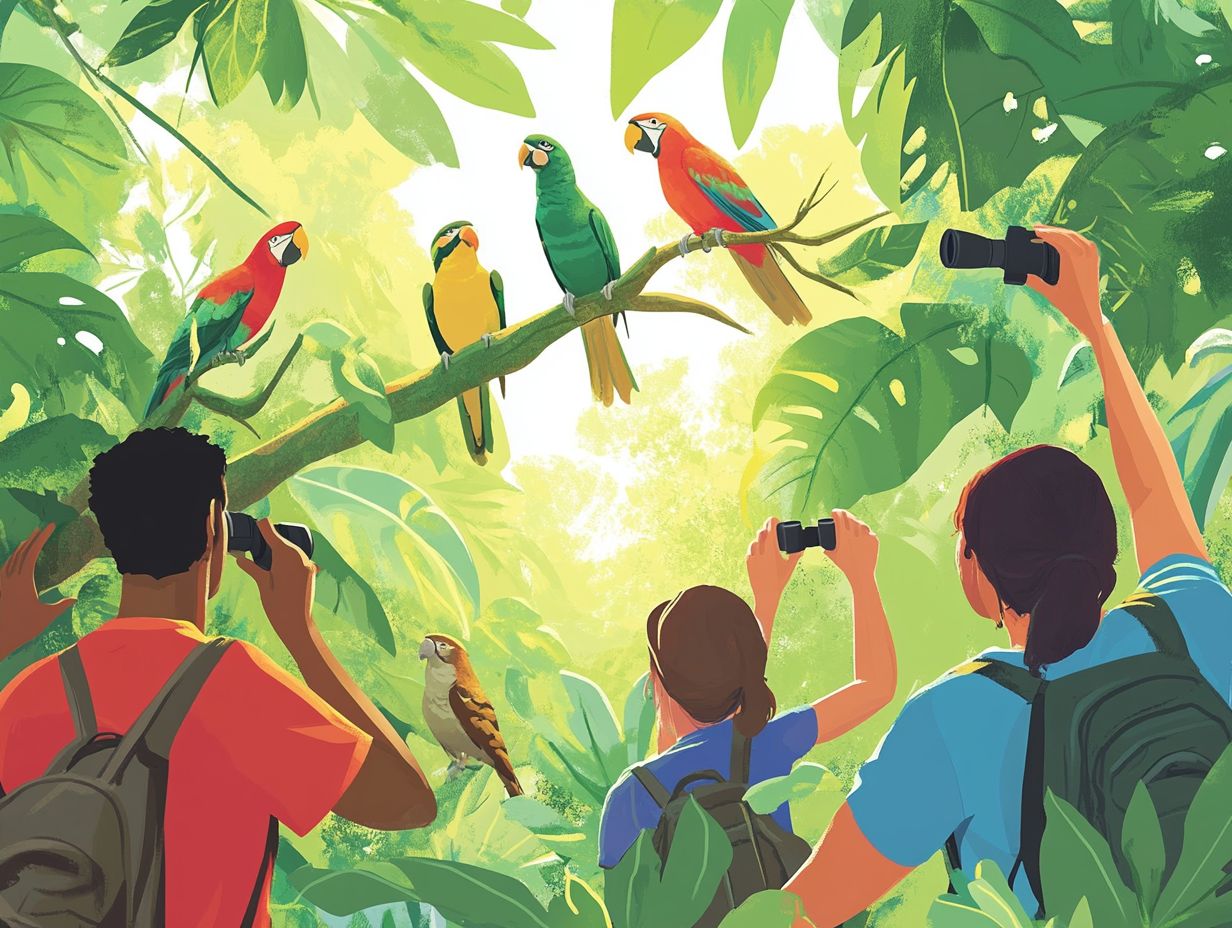
Identifying birds in the wild presents a rewarding challenge that hones your observation skills and enriches your understanding of the natural world. As you engage in careful spotting and species recognition, you nurture your curiosity and elevate your bird watching experience, allowing you to fully appreciate the stunning diversity of avian life.
Get ready to enjoy nature and discover the beauty of bird watching!
Tips for Spotting and Recognizing Different Species
Effective tips for spotting and recognizing different bird species include utilizing the right equipment, honing your observation skills, and understanding bird behavior. These practices can significantly enhance your birdwatching experience. Photography can be an excellent tool for documenting your sightings and improving your identification skills.
Investing in quality binoculars is essential. They allow for close observation without disturbing the birds. Learning about the various habitats the different environments where birds live where specific species thrive is also beneficial. For example, wetlands are ideal for waterfowl, while forests are perfect for songbirds. Observing seasonal behaviors, such as migrations and nesting habits, provides valuable context for your observations.
Remember, patience and silence are crucial; sudden movements or loud noises can send birds flying. Keeping a journal or using mobile apps can help you track your sightings and refine your identification skills, transforming birdwatching into a more rewarding and educational pursuit.
Etiquette and Conservation in Bird Watching
Adhering to proper etiquette and conservation practices in birdwatching is crucial for safeguarding both the birds and their habitats while nurturing a positive community of fellow enthusiasts.
When you commit to responsible practices, you actively help protect birds and their habitats for generations to come.
Responsible Practices for Protecting Birds and their Habitats
Responsible practices include minimizing disturbance, respecting nesting sites, and participating in community conservation efforts. These actions foster a healthier environment for birds and contribute to safeguarding biodiversity and promoting environmental wellness.
Embracing eco-friendly behaviors like using binoculars designed to prevent scaring birds and consciously selecting less intrusive viewing spots can significantly enhance your birdwatching experience without harming wildlife.
Getting involved in community initiatives, such as local clean-up days or habitat restoration projects, amplifies the impact of your efforts, creating a collective force for nature protection.
Encouraging dialogue among fellow enthusiasts fosters a culture of respect and stewardship, where sharing knowledge about migratory patterns and ecological needs enables others.
These interconnected actions highlight the vital role you play in nurturing both local ecosystems and the broader tapestry of global conservation efforts.
Frequently Asked Questions
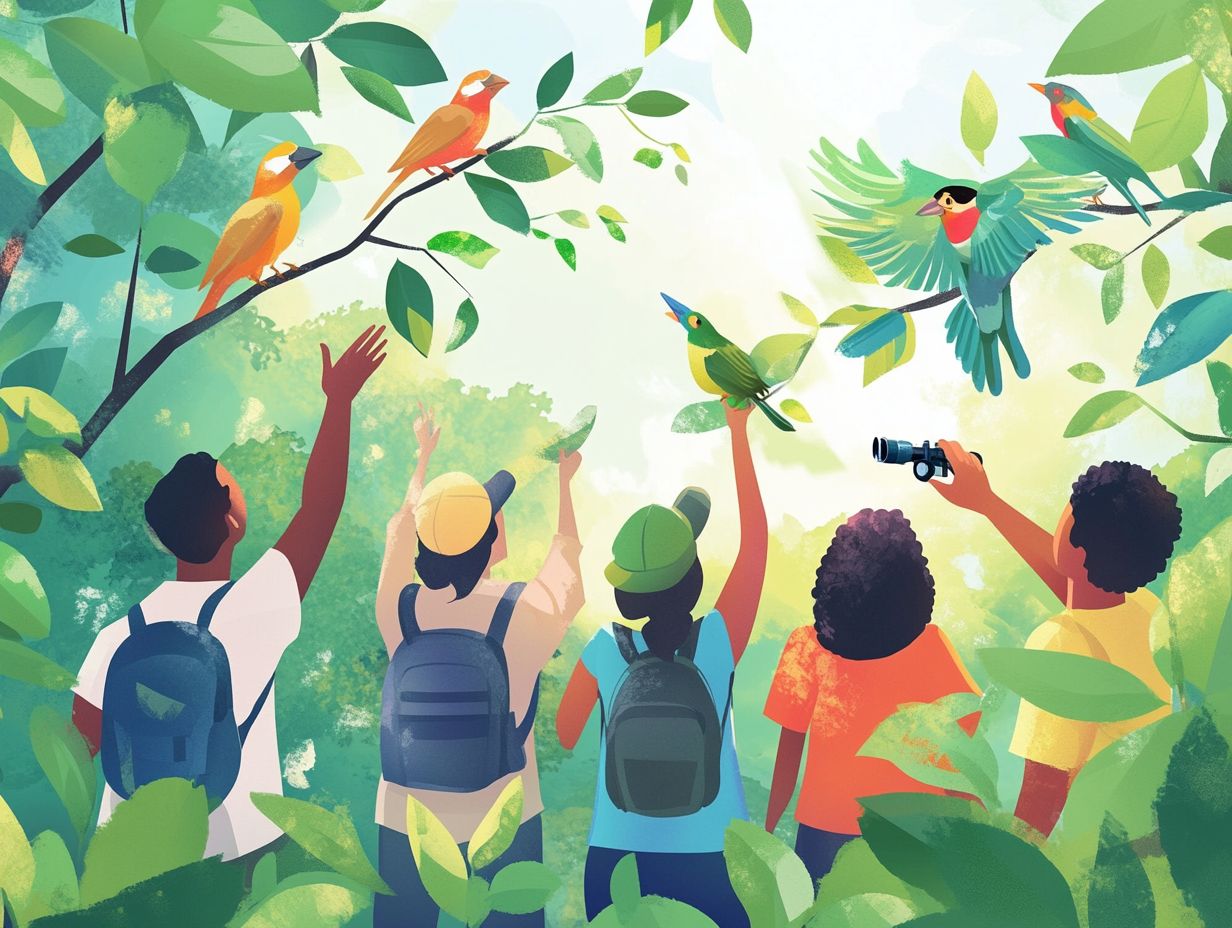
What makes bird watching a unique experience?
Bird watching allows you to connect with nature and observe the beauty and behavior of various bird species. The experience can be life-changing, instilling a sense of perseverance in your quest to observe even the most elusive birds.
Is bird watching only for expert birders?
No, bird watching can be enjoyed by anyone, regardless of their level of experience. It’s a fun and educational activity for all ages, perfect for families looking to explore urban spaces or nature reserves, including places like Central Park or Nine Springs in Dane County.
What Equipment Do I Need for Bird Watching?
All you need is a good pair of binoculars and a field guide. Wear comfortable clothing and shoes suitable for outdoor activities.
Whether you re in North Jersey or exploring Chennai in India, these essentials will help you enjoy the experience.
Can Bird Watching Be Done Anywhere?
Absolutely! Bird watching can take place almost anywhere from your backyard to national parks and nature reserves.
Birds thrive in both urban and rural areas, even in remote locations like Narcondam Island or bustling cities like Bengaluru.
How Long Does a Typical Bird Watching Session Last?
The duration of a bird watching session varies. It can last anywhere from a few minutes to several hours, depending on your location and personal preferences.
Do I Need to Be Quiet While Bird Watching?
While you should be respectful of the birds and their environment, complete silence isn’t necessary. Speaking quietly or whispering is perfectly fine while you observe.

